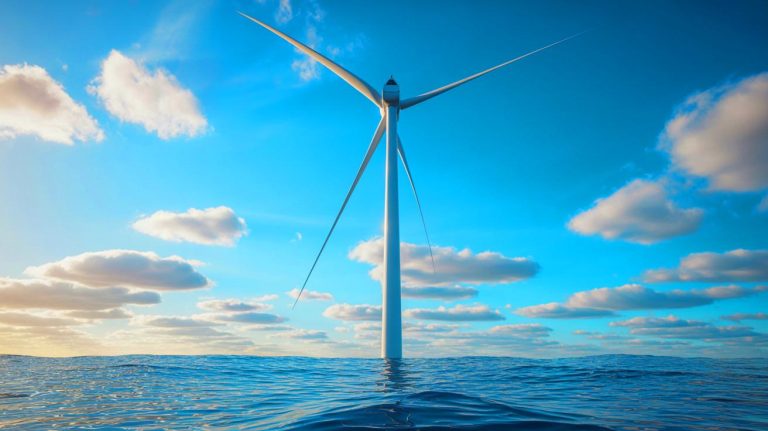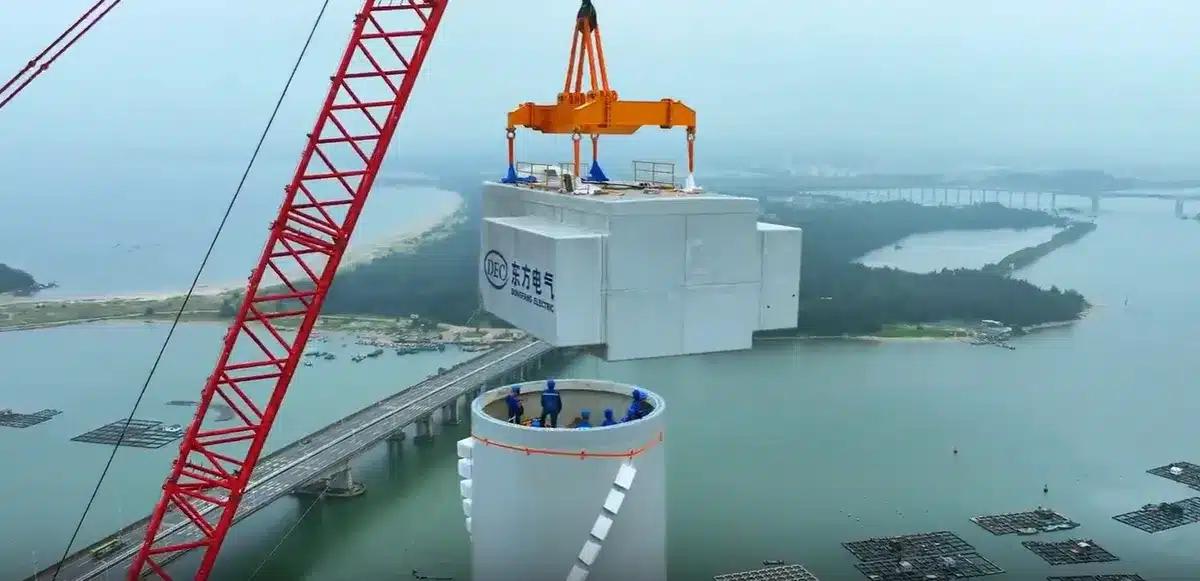| IN A NUTSHELL |
|
China’s ambitious strides in renewable energy continue to capture global attention, with the latest groundbreaking achievement being the construction of the world’s largest wind turbine. Completed in 2024 by the China Dongfang Electric Corporation, this colossal turbine boasts a capacity of 26 megawatts and stands at an astounding height of 607 feet. This technological marvel showcases China’s industrial prowess and raises important questions about the country’s overall energy strategy. As China pushes the boundaries of renewable energy technology, it simultaneously grapples with the complexities of its energy landscape.
A Colossal Offshore Wind Turbine
Located in the offshore wind farm of Fujian Fuzhou, this new turbine is a true giant. With its hub positioned at 607 feet above sea level—comparable to a 63-story building—it is capable of generating approximately 100 million kilowatt-hours of electricity annually, given wind speeds of about 22 miles per hour. Its capacity of 26 megawatts surpasses the previous world record held by an 18-megawatt turbine by a remarkable 31%. This output is sufficient to power 55,000 households while preventing the release of over 80,000 tons of CO₂ each year, thanks to its role in replacing coal-based energy.
Designed to endure the harsh marine conditions of Chinese offshore areas, especially frequent typhoons, the turbine features a reinforced structure and advanced anti-corrosion systems. These enhancements ensure optimal durability despite the challenges posed by salty sea air, solidifying its role as a cornerstone of China’s renewable energy infrastructure.
A Race for Power and Installed Capacity
China has firmly established itself as the global leader in wind and solar energy production. In 2023 alone, the country installed 77.1 gigawatts of wind energy, accounting for nearly two-thirds of the world’s new capacity. The recent unveiling of an 18-megawatt turbine by China Three Gorges Corporation set a record at its time, but the advent of the 26-megawatt turbine underscores the rapid advancements in Chinese technology within this sector.
China’s progress in solar energy is equally impressive. Between March 2023 and March 2024, the nation added more solar capacity than in the previous three years combined, surpassing even the global installed solar capacity for 2023. These efforts have enabled China to achieve its national target of 1,200 gigawatts of combined wind and solar energy ahead of schedule, further cementing its leadership in the renewable energy domain.
The Coal Paradox
Despite its renewable energy leadership, China remains paradoxically reliant on coal. In 2024, the country began constructing 94.5 gigawatts of new coal-fired power plants and revived 3.3 gigawatts of previously suspended projects. This pace is the highest in a decade, highlighting the challenges China faces in rapidly decarbonizing its economy.
Coal continues to be the principal source of electricity in China, which is also the world’s largest emitter of greenhouse gases. This paradox between massive investments in clean energy and the expansion of coal illustrates the tensions between economic growth, energy security, and ecological transition. As China navigates these complexities, the world watches closely, pondering the implications for global energy dynamics.
China’s dual approach to energy—pioneering renewable technologies while expanding coal use—presents a complex narrative. This multifaceted strategy reflects the nation’s drive to balance economic growth with environmental responsibilities. As China continues to innovate and expand its energy capacities, how will this affect its role in the global transition toward sustainable energy solutions?
Did you like it? 4.4/5 (24)







Wow, 607 feet tall! That’s taller than most skyscrapers. 🤯
Kudos to China for this achievement, but let’s hope they address the coal issue soon.
Is there any comparison between this and the largest U.S. turbines?
How long do these turbines typically last before needing replacement?
China’s dual approach to energy is a real head-scratcher. 🤔
Are there any environmental risks associated with such large wind turbines?
It’s amazing how far wind technology has come in recent years!
Does this mean lower electricity bills for those 55,000 households? 🌬️
How does this turbine compare to others in terms of efficiency?
The article mentions a hidden flaw. Can anyone elaborate on this?
Why the heavy reliance on coal if they’re leading in renewable energy?
Can we expect more of these giant turbines around the world soon?
26 megawatts is mind-blowing. What was the previous record again?
China’s energy strategy is ambitious but seems very complex. 😅
How do they transport such massive parts to the offshore site?
Exciting news for renewable energy! Hope other countries follow suit.
I wonder how this will affect local wildlife and marine life.
What’s the environmental impact of building such large turbines offshore?
These achievements are great, but how sustainable is it in the long run?
China’s balancing act between coal and renewables is fascinating.
Are there plans to build even larger turbines in the future?
It’s impressive, but why is China still investing so heavily in coal?
Is this part of China’s strategy to reduce their carbon footprint?
Sounds like a giant leap for renewable energy! 🚀
Is the technology used in this turbine something new and innovative?
Does this mean wind energy will become cheaper globally?
Powering 55,000 households is no small feat. Thanks for sharing this info!
Does anyone else think this is like the Eiffel Tower of wind turbines? 😂
What exactly is the hidden flaw that threatens the whole project?
China’s commitment to renewables is admirable, but are they truly sustainable?
Can this turbine withstand extreme weather like typhoons?
I wonder how much it costs to build something this massive. 💰
Why are they still building new coal plants? Seems counterproductive.